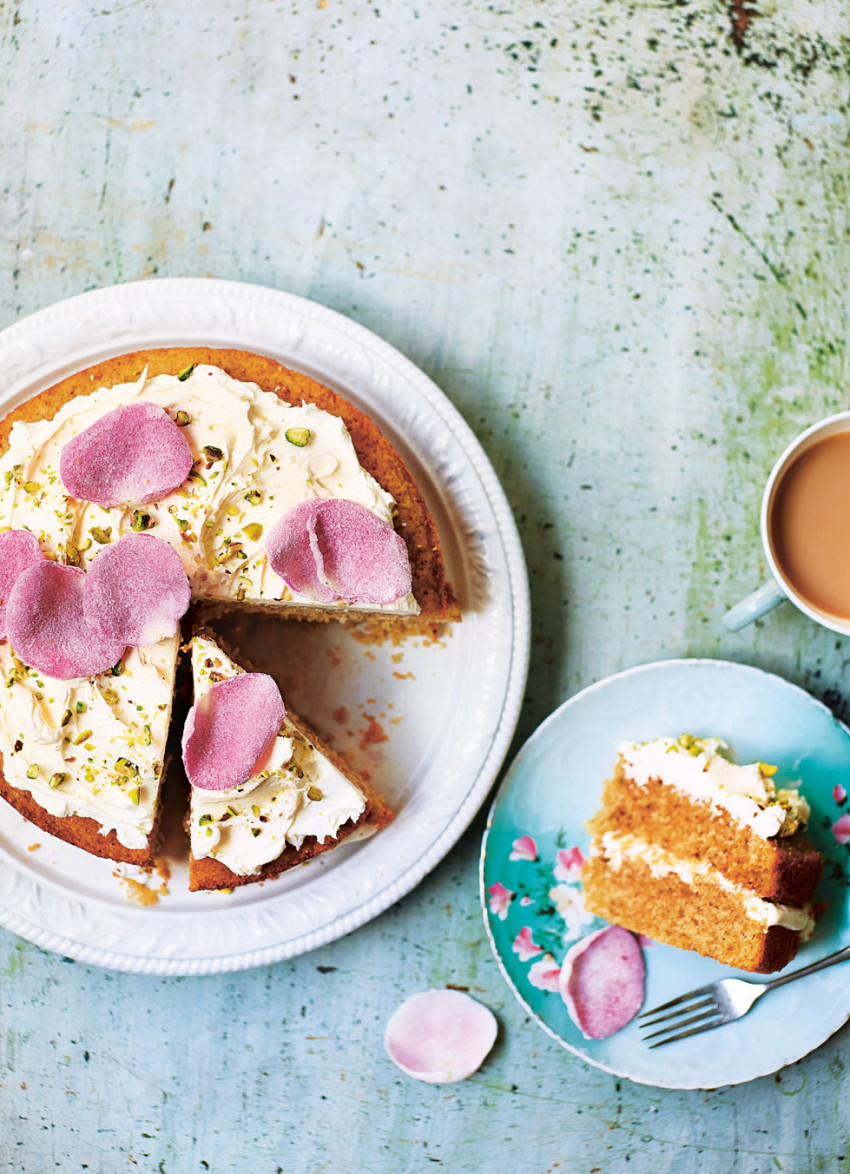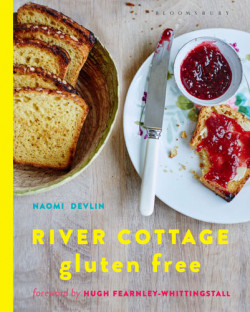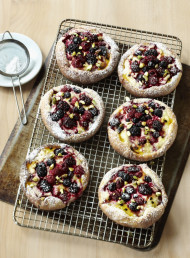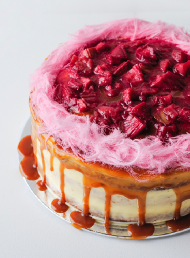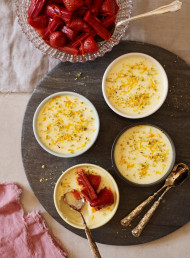Naomi Devlin's new book River Cottage Gluten-Free is brimming with gorgeous, inspiring recipes everyone can enjoy. A few teaspoonfuls of rosewater, a handful of pistachios and a scattering of rose petals elevate this simple cream-filled sponge to something exotically redolent of a Persian flower garden.
Serves: 8–10
INGREDIENTS
230 grams salted butter, softened, plus extra for greasing
180 grams light muscovado sugar
4 teaspoons rosewater
2 teaspoons vanilla extract
4 large eggs, beaten
160 grams potato starch
3 teaspoons gluten-free baking powder
160 grams ground almonds
For the filling and topping
225ml double cream
1 quantity rose buttercream (recipe below), or extra whipped cream
50 grams pistachio nuts, finely chopped
Fresh or crystallised rose petals (optional)
2 x 20cm sandwich tins
Rose buttercream
150 grams icing sugar
100 grams salted butter, softened
½ teaspoon rosewater
4–6 teaspoons milk
Some sugared rose petals are always gorgeous on any cake flavoured with rosewater: just paint the petals with egg white, toss them in a bowl of caster sugar and lay to dry on kitchen paper in a warm, dry place for 6–24 hours, until crisp.
METHOD
Preheat the oven to 180°C/Fan 160°C/Gas 4. Line the base of the cake tins with discs of baking parchment and butter the sides.
Cream the butter, sugar, rosewater and vanilla extract together in a bowl with an electric hand whisk or balloon whisk until light and fluffy. Gradually add the eggs, beating well between each addition. If it looks like the mixture is starting to curdle, add a couple of tablespoonfuls of the potato starch and beat again – it should come right.
Sift the potato starch, baking powder and ground almonds together over the mixture and fold in gently but thoroughly.
Scrape into the prepared tins and gently level the surface. Bake for 25–30 minutes until golden, springy to the touch and a skewer inserted into the centre comes out clean.
Leave in the tins for 10–15 minutes, then run a thin bladed knife around the inside of the tins. Turn out the cakes and place, right side up, on a wire rack. Leave to cool.
When the cakes are completely cold, whip the cream until thick, but not grainy. Put one of the cakes onto a plate and spread the cream almost to the edge. Place the other cake gently on top and twist it back and forth a little, just until the cream is peeking out between the layers.
Pipe or spread the buttercream (recipe below) over the top of the cake, or top with more whipped cream. Sprinkle with chopped pistachios and scatter over a few fresh or crystallised rose petals if you have them.
Rose buttercream
This is not as sweet as a typical buttercream. Choose a delicious organic butter, as this is the major flavour. I generally use salted butter because I like the way it balances the sweetness; if you use unsalted, add a pinch of salt to bring out the butteriness. Take the butter out of the fridge about 20 minutes ahead to soften a little, but no longer than 30 minutes, or you will end up with icing that is too soft to use.
Put the icing sugar, butter and rosewater into a bowl and mash together with a wooden spoon until all the icing sugar is damp and the butter is broken down a bit. Swap to an electric hand whisk if you have one and beat until the mixture is starting to lighten.
Add the milk, 1 teaspoon at a time, beating well between each addition. You may not need all the milk, so check after 4 teaspoons to see if you like the texture.
Use a palette knife to spread the buttercream onto your cake(s), or pipe it on if you prefer. Buttercream made with dairy milk needs to be eaten within 48 hours; if using dairy-free milk, it keeps a little longer.
Cook's Tip: When adding the rosewater it's best to taste as you go – rosewater varies in strength and you may need less if you have a particularly strong one. If you're after a pink colour, add the merest drop of red food colouring – go for the palest sugar pink rather than candy floss.
Keep up to date with
dish weekly recipes,
food news, and events.
latest issue:
Issue #120
As the days become shorter, and the nights cooler, the latest issue is perfectly timed to deliver delicious autumn dishes. From recipes using fresh seasonal produce such as feijoas and apples, to spectacular soothing soups and super-quick after-work meals in our Food Fast section, we’ve got you covered. With Easter on the horizon, we feature recipes that will see you through breakfast, lunch and dinner over a leisurely weekend holiday, and whip up chocolatey baking treats sure to please. We round up delicious dinners for two and showcase a hot new Korean cookbook before heading south to Dunedin to check out all that’s new in food and dining.The latest issue of dish is on sale NOW at all good bookstores and supermarkets – don’t miss it!

